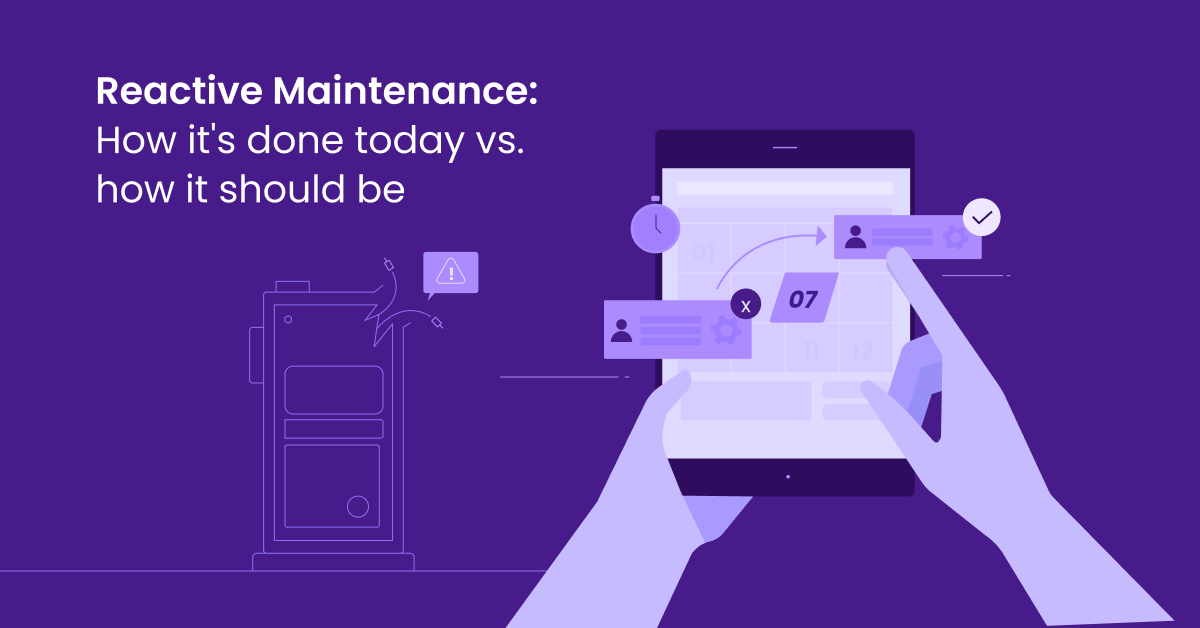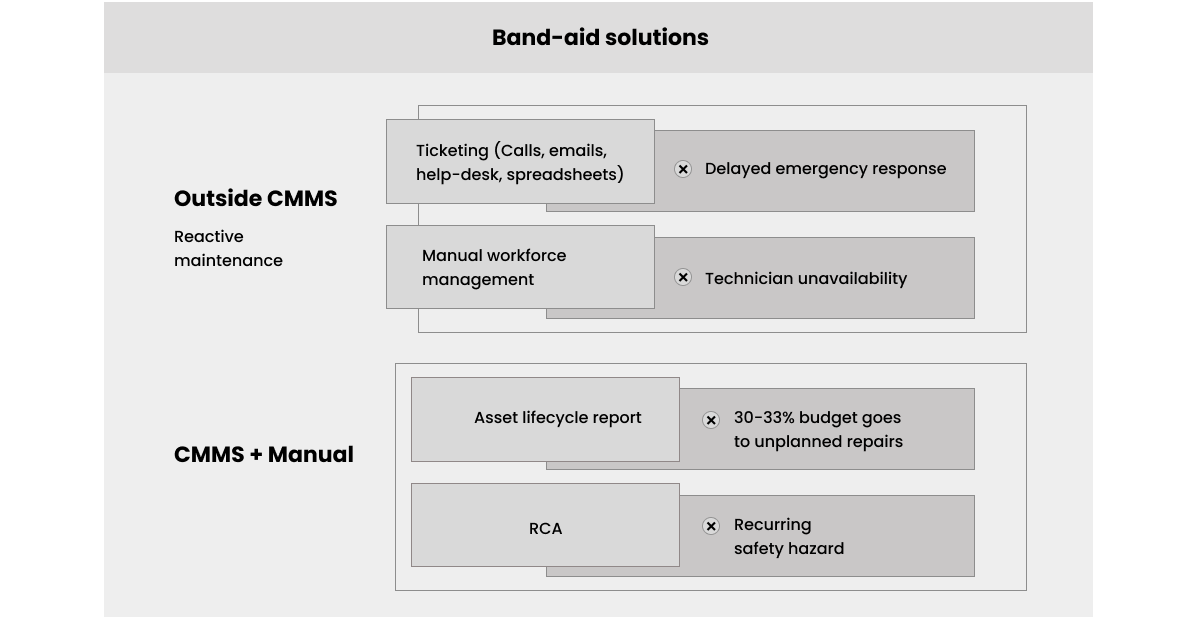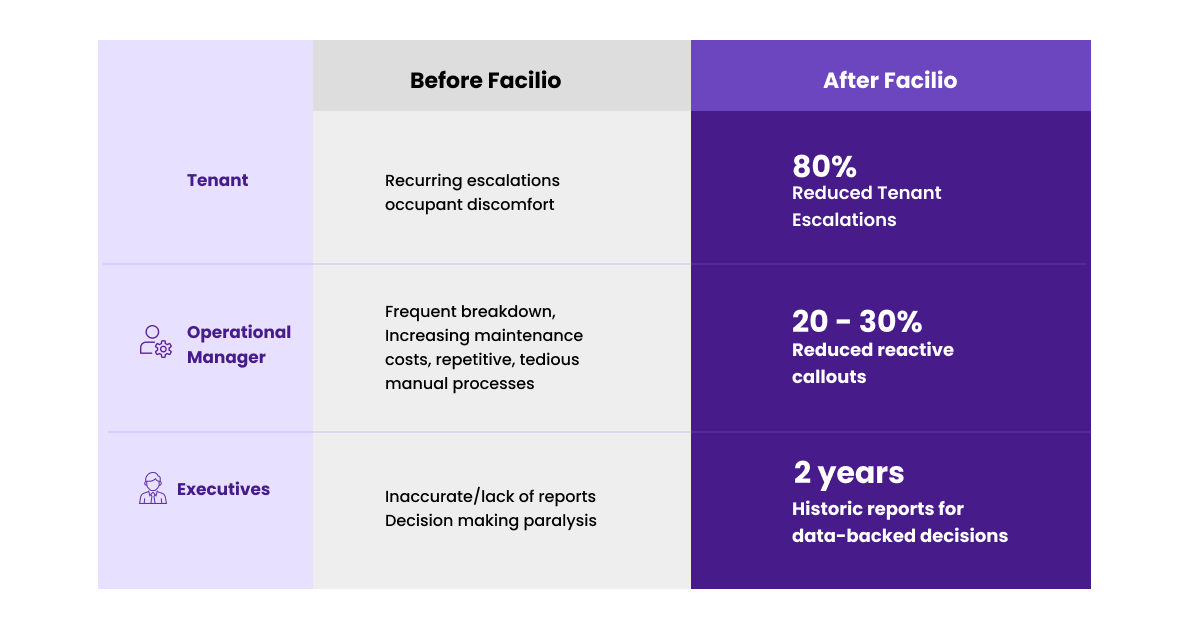Operational Excellence
Reactive maintenance: How it is done today vs. how it should be

Legacy CMMS doesn’t quite cut it for managing reactive work load and O&M teams are struggling to keep up. Here’s why:
Build O&M involves multiple stakeholders and is often just used as a system of records. O&M leaders claim most maintenance work happens outside their CMMS leading to SLA non-adherence and multiple escalations. Reactive work loads have delayed responses, lack clarity on technician availability and more than 30% budget goes into unplanned repairs. Moreover, critical tasks often get overlooked with a steep increase in reactive maintenance costs.
On a busy day, how does the operations team manage reactive workload?
Managing reactive maintenance with a legacy CMMS is a manual process with increased operational disruptions, unclear technician schedules, lack of visibility into inventory stocking leading to unexpected expenses due to emergency parts shipping, travel time and additional workforce support. Asset lifecycle is compromised and to plug in gaps, O&M teams often rely on multiple point solutions.
An effective reactive maintenance program should have a threshold of 15% of the total maintenance workload but while O&M teams majorly focus on preventive maintenance, reactive maintenance is largely ignored and comes as a struggle for managers with balancing resources against demands.
The unpredictability of reactive maintenance has direct impacts on not just customer satisfaction and resolution time but also operational struggles such as assets and inventories against the workload, expenses and technician schedules and if reactive maintenance is above 15%, the approach should be towards preventive and predictive maintenance.

Reactive Maintenance: How it is done today
Based on a poll conducted by Facilio, we asked O&M leaders about the significant reactive maintenance problems they faced; 76% of respondents resonated with manual tracking of service requests and lack of visibility in response times and SLAs, and the rest chose difficulty scaling operations.
The process of raising a service request today is time consuming and inefficient. Occupants raise a reactive maintenance request, to a vendor via emails and calls, and get delayed responses from the FM teams. This is mainly due to multiple point solutions such as ticketing tools, an ERP solution to keep a record of service requests, a system for inventory, an invoicing system to keep track of payments, vendor communication, and management via Excel and asset information on the CMMS. Multiple point solutions lack singularity, cause manual intervention, and require more time to resolve issues.

However, a connected CMMS approach caters to all stakeholders and centralizes building operations by integrating - People (Technicians, supervisors, vendors, tenants), Systems (OT/IT systems), and processes.
Streamlining unexpected reactive call outs with a connected CMMS
Traditional CaFM has limitations, and we need a connected approach that lets your CMMS become the single pane of glass to analyze data at scale and gauge the strengths and weaknesses in your portfolio through a single platform. Your solution should also be able to communicate with other tools and bidirectionally share data.
Here’s how a simplified version of reactive maintenance looks through a connected CMMS: All requests are routed through a single platform (Facilio) and managed centrally while every stakeholder is notified. This way budget approval processes, purchase orders, vendor communication and work order completion is all visible through a single pane. Occupant and tenant feedback can also be collected in order to benchmark resolution time.
User journey in a reactive maintenance perspective across different personas
Tenant Engagement
Tenants are able to raise service requests and track them in a seamless manner. They also have access to the history of all requests; their current status, rejected requests, and their reasons. They can also chat with the maintenance teams, reducing manual ticketing process inefficiencies. Tenants can also access a service catalog and communicate via a tenant community, all via a single platform. This directly increases tenant satisfaction.
Vendor Engagement
A building portfolio has multiple vendors, and vendors have multiple clients to cater to. Unfortunately, this means service requests piling up and vendor management becomes tedious. Through a connected CMMS, vendors can:
1. Assign work orders to technicians based on technician availability and WO priority
2. Raise a PO, quote
3. Request inventory
4. Update work order status to reflect the progress.
Maintenance Supervisors
Supervisors can automatically triage incoming service requests and approve, reject, or assign them to internal or external vendors. They can track critical SLAs such as vendor performances and resolution time, incorporate vendor documents and checklists, and automate work permits to external technicians all through a single application.
Internal Technicians
Once the supervisor approves service requests, work orders are automatically generated and assigned to a technician. Facilio’s connected CMMS now tracks crucial metrics such as start and stop times and compares resolution times to the committed SLAs. Technicians' workflows are customizable and automated which means they can start, stop, pause, or resume work, and these statuses will automatically reflect on the work order.
Digitizing and streamlining reactive maintenance with Facilio’s connected CMMS
Facilio’s connected CMMS is a centralized platform to manage operations and maintenance across portfolios through a single platform. It enables improved workforce mobility and performance by effectively allocating and managing field workforce and workload spikes with the help of dedicated portals and apps for all stakeholders. It also aids in compliance and operational insights through real time reports on reactive maintenance with historical data and asset lifecycle management.
In March, Facilio conducted a knowledge-sharing session on the cure to legacy software compromises by enabling reactive maintenance & obtaining operational visibility with a Connected CMMS approach. Access the free webinar here and check out how a connected CMMS approach can help streamline reactive maintenance for all the stakeholders involved in the ecosystem.



